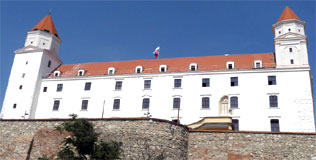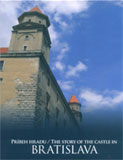Historical Attractions of Old Bratislava
The Castle
 Built on the Castle Hill it dominates the center of Bratislava and its four towers became a symbol of the city. Inhabited from neolitic Hallstadt and Roman eras. First mentioned in 907.
Built on the Castle Hill it dominates the center of Bratislava and its four towers became a symbol of the city. Inhabited from neolitic Hallstadt and Roman eras. First mentioned in 907.

More information:
 Bratislava - Picture Tour I.
Bratislava - Picture Tour I.
 The Bratislava Castle
The Bratislava Castle
 Pribeh hradu / The Story of the Castle in Bratislava
Pribeh hradu / The Story of the Castle in Bratislava
The House At the Good Shepherd
 Burgher rococo house of the 2nd half of the 18th century was built for a merchant of Bratislava. After reconstruction in 1975, the City Museum opened there a unique exposition of historical clocks.
Burgher rococo house of the 2nd half of the 18th century was built for a merchant of Bratislava. After reconstruction in 1975, the City Museum opened there a unique exposition of historical clocks.
More information:
 Bratislava City Museum
Bratislava City Museum

Dome of St. Martin
 The three-nave Gothic church was built in the place of the original Romanesque church. They started building it in the beginning of the 14th century and it was consecrated in 1452. Dimensions of the church are also remarkable: length 69.37 m, width 22,85 m, height 16.02 m. Several chapels were added to the church – Gothic chapel of St. Sophia, widow after the Czech King Wenceslas IV, chapel of St. Anna and baroque chapel of St. John the Almoner.
The three-nave Gothic church was built in the place of the original Romanesque church. They started building it in the beginning of the 14th century and it was consecrated in 1452. Dimensions of the church are also remarkable: length 69.37 m, width 22,85 m, height 16.02 m. Several chapels were added to the church – Gothic chapel of St. Sophia, widow after the Czech King Wenceslas IV, chapel of St. Anna and baroque chapel of St. John the Almoner.
Tower of the church was constructed simultaneously with 3 naves of the church, while it was integral part of city walls serving to defend the town. Its height is 85 m and there is a gilded pillow of dimensions 2 m x 2 m on the top, while a 1 m high copy of the Hungarian royal crown weighing 300 kg is placed on it. In the 16th century, the Dome witnessed coronation of Hungarian Kings. Within 1563 – 1830, there were crowned 11 Hungarian Kings and 8 royal wives. Beethoven‘s Missa Solemnis was played for the first time in this church.
Read more about Sacral art in the Dome of St. Martin.

The sculptural group of St. Martin in the Dome of St. Martin
It was created by Georg Raphael Donner for the main altar of St. Martin in 1734. Nowadays, the sculptural group is in the side nave of the church as a free statue on a quadrangular pedestal. It represents Saint Martin sitting on rampant horse, bending to a beggar and cutting his overcoat to share it with the poor man.It is the first monumental work of Central-European sculpture.
Read more about G. R. Donner.


The Old Town Hall
There used to be a house with a tower in its place in the 14th century, which was built upon order by the mayor Jacob. The Old Town Hall arose in the 15th century by connecting several burgher houses and it went through several reconstruction in the course of centuries. After earthquake of 1599, it was reconstructed in Renaissance style, while the town-hall tower was rebuilt in baroque style in the 18th century and in 1912 the rear wing was constructed in neorenaissance style from the side of the courtyard and neogothic style from the side of the Primacial square. The town-hall tower was of defensive nature. At the bottom, you may find a table with the date of February 1850 reminding the water level upon flood, when the Danube ran out of its bed. Left of the Gothic window, there is immured a cannon ball reminding attacks of Napoleon troops in 1809. At the corner of the tower, the statue of Madonna of 1676 is located. Decisions of the assembly, royal decrees and orders of town council were announced from the balcony of the tower in the past. Note a fresco of an old man of 1533 as well as a statuette of the Hungarian King – St. Ladislaus. The Municipal museum is the oldest museum of Bratislava, as it was founded in 1868. Entrance to the exposition of feudal justice system and history of the town is in the corner of the courtyard.
 The reconstructed Old Town Hall has been open again on July 1, 2011 after three years.
The reconstructed Old Town Hall has been open again on July 1, 2011 after three years.
More information:
 Bratislava City Museum
Bratislava City Museum
Roland Fountain
 Emperor Maximilian II had the Renaissance Roland fountain on the Hlavna namestie (Main square) built, when a big fire broke out in the town after his coronation in 1563. Its author is a stonemason Ondrej Luttringer from Deutsch Altenburg, who completed it in 1572. The fountain consists of a massive circular tank 9 meters in diameter. In the middle of the tank, there is standing a 10.5 m high column concluded with a statue of a knight in suit of armor, who represents the knight Roland, a legendary defender of city rights. Others consider it to be a portrait of Maximilian II.
Emperor Maximilian II had the Renaissance Roland fountain on the Hlavna namestie (Main square) built, when a big fire broke out in the town after his coronation in 1563. Its author is a stonemason Ondrej Luttringer from Deutsch Altenburg, who completed it in 1572. The fountain consists of a massive circular tank 9 meters in diameter. In the middle of the tank, there is standing a 10.5 m high column concluded with a statue of a knight in suit of armor, who represents the knight Roland, a legendary defender of city rights. Others consider it to be a portrait of Maximilian II.
More information:
Roland, Maximilian a potrestani cikajuci chlapci
The Franciscan Church and Monastery
 It ranks among the oldest sacral buildings of the city. The Franciscan church was constructed in Gothic style in the 13th century. It was consecrated in 1297 in presence of the King Andrew II. In the 17th century, it was rebuilt in Renaissance style and, in the 18th century in baroque style. The complex of several buildings on gothic foundations dates back to the 14th and 15th centuries. In the course of the 17th and18th centuries, it was several times rebuilt, for the last time in classicist style within 1860 – 1861. In the beginning of the 15th century, a Gothic tower was placed on walls of the cloister, part of which was damaged and replaced with its copy in 1897. The cloister was witness to many historic events. In Middle Ages, there was elected mayor, while the Hungarian assembly elected Ferdinand of Habsburg in 1526 to become the king.
It ranks among the oldest sacral buildings of the city. The Franciscan church was constructed in Gothic style in the 13th century. It was consecrated in 1297 in presence of the King Andrew II. In the 17th century, it was rebuilt in Renaissance style and, in the 18th century in baroque style. The complex of several buildings on gothic foundations dates back to the 14th and 15th centuries. In the course of the 17th and18th centuries, it was several times rebuilt, for the last time in classicist style within 1860 – 1861. In the beginning of the 15th century, a Gothic tower was placed on walls of the cloister, part of which was damaged and replaced with its copy in 1897. The cloister was witness to many historic events. In Middle Ages, there was elected mayor, while the Hungarian assembly elected Ferdinand of Habsburg in 1526 to become the king.
(Franciscan Square)
More information:
Zosadena veza

The Primate’s Palace - a Witness of History
 The Primate’s Palace is one of the most valuable architectural monuments in Bratislava. Classicist palace was built in 1778 - 1781 on orders of the archbishop of Esztergom, cardinal Jozef Batthanyi. The architect was Melchior Hefele. The most famous is the Hall of Mirrors in which the Bratislava Peace was signed in 1805 after the battle of Austerlitz (Slavkov), between Francis I and Napoleon. The most precious exhibit, exceeding by its uniqueness the framework of Slovakia, is a collection of six tapestries.
The Primate’s Palace is one of the most valuable architectural monuments in Bratislava. Classicist palace was built in 1778 - 1781 on orders of the archbishop of Esztergom, cardinal Jozef Batthanyi. The architect was Melchior Hefele. The most famous is the Hall of Mirrors in which the Bratislava Peace was signed in 1805 after the battle of Austerlitz (Slavkov), between Francis I and Napoleon. The most precious exhibit, exceeding by its uniqueness the framework of Slovakia, is a collection of six tapestries.
In the attic of the roof, there are allegorical statues by J. Kögler and F. Prokop as well as vases by J. A. Messerschmidt. In the top of tympanum, there is a coat of arms of Jozef Bathyany and a cardinal‘s hat weighing 150 kg. A mosaic by Ernest Zmetak is placed in the tympanum. Statuettes of angels in the facade are holding the letter I – Iusticia = justice and C – Clementia = graciousness – personal slogan of the cardinal. In the entrance hall of the palace on the right-hand side, there is a memorial tablet reminding of signing the Bratislava Peace in 1805. A fountain of St. George is in the courtyard and the entrance to the chapel of St. Ladislaus can be found in the corner of the courtyard. You may find the Hall of Mirrors on the first floor.
The palace is a seat of the mayor of the city at present.
Collections of the City Gallery of Bratislava are located in representative rooms with a unique collection of tapestries of the 17th century depicting tragic love of Hero to Leandros from an English royal weaving factory at Mortlake. There is also the permanent exposition of European Painting of the past centuries and ocassional exhibitions.
More information:
Primate`s Palace and six tapestries
 Treasures in Three Palaces - the City Gallery of Bratislava
Treasures in Three Palaces - the City Gallery of Bratislava
Odkial prichadzas, rytier Juraj?
Michael‘s Gate
 The only preserved gate of medieval city fortification. Its Gothic foundations were laid in the 1st half of the 14th century. Within 1511 – 1513, it was heightened and rebuilt to its present appearance within 1753 – 1758, when a statue of St. Michael was placed on the top of 51-metre high tower. At present, the Museum of Weapons and City Fortifications is located in the tower. A very nice view of the old city is provided from the tower.
The only preserved gate of medieval city fortification. Its Gothic foundations were laid in the 1st half of the 14th century. Within 1511 – 1513, it was heightened and rebuilt to its present appearance within 1753 – 1758, when a statue of St. Michael was placed on the top of 51-metre high tower. At present, the Museum of Weapons and City Fortifications is located in the tower. A very nice view of the old city is provided from the tower.
More information:
 Bratislava City Museum
Bratislava City Museum
Academia Istropolitana
 The oldest university in the territory of nowadays Slovakia founded by the King Mathias Corvinus in 1465. After his death, the university ceased to exist in 1490. In the building, which is today a national monument of cultural legacy, the Academy of Music and Drama has its seat.
The oldest university in the territory of nowadays Slovakia founded by the King Mathias Corvinus in 1465. After his death, the university ceased to exist in 1490. In the building, which is today a national monument of cultural legacy, the Academy of Music and Drama has its seat.
Chatam Sofer Memorial
 Jewish funerary shrine and place of religious worship.
Jewish funerary shrine and place of religious worship.
More information:
Chatam Sofer Memorial
The Slovak National Theater

The building was constructed within 1884 – 1886 on the basis of designs of Viennese architects F. Fellner and H. Helmer in place of the original theater of estates. Since 1920, it is domicile of the Slovak National Theater, who moved to its new building in 2007. There were performing the most outstanding personalities of the world opera scene as F. Saliapin, P. Mascagni, R. Strauss, G. Filip, M. Freni, P. Capuccili, R. Reznikov, J. Obrazcova, dancers M. Fonteyn, A. Alonso, V. Vasiliev and many others. At present, there are residing opera and ballet companies in it. It brought up many renowned personalities of opera scene, as e.g. P. Dvorsky, J. Kundlak, J. Galla, E. Jenisova, E. Gruberova, L. Poppova, who were performing at the best known world stages.

The Grassalkovich Palace (The Presidential Palace)

Baron Anton Grassalkovich, one of the most prominent Austro-Hungarian politicians during the reign of the enlightened monarch Queen Maria Theresa, had the Palace built in the 1760s as his summer residence. The Queen, having a close relationship with the Baron’s family, visited the residence personally in 1775. Since then its ownership has changed hands many times. In World War I, the palace was home to the military General Staff, and during World War II, the Palace became the seat of the Slovak President. During the communist era, the building was used by the 'Pioneer' youth organization. The palace underwent extensive renovation in the 1990s, and once again became the seat of the President of the Slovak Republic in 1996.
The palace - now fully restored to all its former late 18th-century Baroque glory - is entered through a courtyard, where visitors are welcomed by the Presidential Guard of Honor. The ceremonial staircase in the entrance hall, adorned with original sculptures, is something quite unique in Bratislava. The garden hall and the Chapel of St. Barbara are decorated with original Rococo and Classicist frescos, which only came to light during the palace's recent thorough renovation. The main hall has a partially original, richly gilded stucco decoration and once served as a ballroom and concert hall, but is nowadays used for official receptions and the signing of important treaties. Part of the wooden paneling in the former music room - which is now used as a reception room by the Head of State - has been preserved, alongside pictures over the door depicting allegories of music, song, and dance. The Presidential Palace gardens are open to the public and are much appreciated by citizens and visitors to the Slovak capital alike.

The Devin Castle. Author / source: Vlado Bibel.
Castles in Bratislava Surroundings
There are many ruins as well as castles and mansions near the Bratislava city. The picture shows Devin Castle.
More information:
Trip Tips to Bratislava and Surrounding
This page is a part of Online Bratislava Guide.
More information:
 Online Bratislava Guide
Online Bratislava Guide
 Bratislava and Surroundings- Guidebooks and Maps
Bratislava and Surroundings- Guidebooks and Maps
Published: 2015-01-15
Updated: 2015-01-15
Categories: Historical Attractions




























